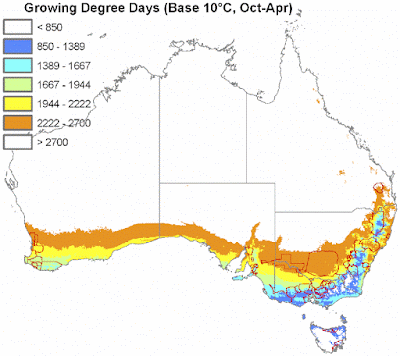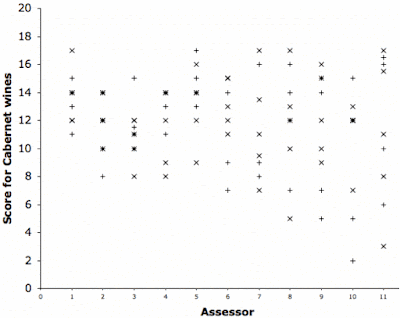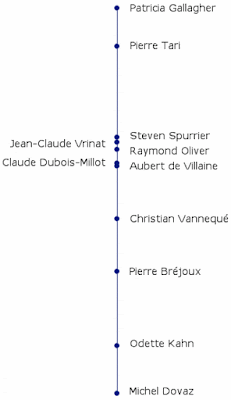To some people, the concept of a government-controlled monopoly is like a red rag to a bull — basically, they "abhor governmental pricing and entry controls as manifestly causing waste and inefficiency, while denying consumers the range of price and service options they desire" (
Paul Stephen Dempsey).
For example, we could cite the example of Santiago (in Chile), which turned its transport system from a commercial one that earned a profit of $60 million per year into a government-controlled one that now loses $600 million per year, instead (see
Planning order, causing chaos: Transantiago). However, we should not conclude from this that all public transportation industries are universally reviled as either wasteful or inefficient (cf. trains in Europe or Japan).
It should not come as a surprise that a number of government-regulated locales exist in the wine industry, as well, notably in the USA (eg.
Pennsylvania Liquor Control Board), Canada (eg.
Liquor Control Board of Ontario), Norway (
Vinmonopolet) and Sweden (
Systembolaget).*
1 Similarly, there is no need to
assume that pricing and availability of wines in any of these regulated environments is in any way inadequate, for the consumers; but this is definitely worth investigating.
In this blog post, I present a specific example of a wine monopoly at work. I first encountered wine retailing as a consumer in Australia, where liquor retail licenses are issued by the government but there is otherwise little interference; and I now live in Sweden, where liquor retail is government-owned (but not trade sales), although
Systembolaget is operated as an independent retail entity. As a consumer, I have therefore seen both types of systems.
My intention here is not to decide whether a monopoly is "good" or "bad", but simply to describe a monopoly at work. It seems to me that I am no worse off in Sweden than I was in Australia, but the systems definitely work differently.*
2
Where Swedes get alcohol
The Swedish Association of Alcohol and Drug Information (
Centralförbundet för alkohol- och narkotika-upplysning) estimated that,
during 2016, Swedes acquired alcoholic beverages in the following ways:
Systembolaget
Traveller imports
Restaurants
Low-alcohol beer
Smuggled drinks
Home-made
Internet shops
|
63.2%
12.5%
10.8%
5.5%
4.9%
1.8%
1.3%
|
Low-alcohol beer is available for sale in supermarkets, etc, while all stronger drinks (>3.5% alcohol) are available for retail sale only in Systembolaget's shops. Trade sales (restaurants, caterers, bars, etc) can be made direct from the importers (remember, Sweden makes very little wine of its own). There is free trade among all countries of the European Union, so that internet sales within the Union are straightforward. Traveller imports have dropped from 25.7% in 2004, given that there is no longer duty-free travel within the European Union (with certain specified exemptions).
So, we can see that Systembolaget is responsible for nearly two-thirds of alcohol acquisition within a country of c. 10 million people, more than 75% of whom are of drink-purchasing age (>20 years; drinking age is >18 years). That's a lot of customers for a single retail entity, with a reported alcohol consumption of 9 liters per adult per year. For 2017, Systembolaget
reported net sales equal to US$ 3.4 billion, with a 1% profit (which goes to the government).
Sytembolaget
I have written before about the fact that Systembolaget manages to sell mid- and high-quality wines more cheaply than in Britain (
Why is wine often cheaper in Sweden than elsewhere?), precisely
because it is government-regulated, and therefore the profit margin is controlled by legislation.*
3 Indeed, the
stated objective of Systembolaget is: "To minimize alcohol-related problems by selling alcohol in a responsible way, without profit motive."
Here, I discuss the range of beverages available to Swedes, which is at least as wide as most other places — this results from the sheer size of Systembolaget, along with Sweden's membership of the European Union. In 2017, Systembolaget
reported selling (in millions of liters):
Spirits
Wines
Beer (>3.5%)
Cider and mixed drinks
Alcohol-free drinks |
19.2
199.5
242.0
19.0
3.4 |
Systembolaget has c. 438 shops throughout the country, plus another c. 500 agencies where products can be ordered and received.*
4 So, no Swede lives very far from a service point. This is important because, while home delivery is available in a number of places for a fee, there is no delivery cost if you collect the product yourself — you simply ask for it to be delivered to your nearest pickup point. There is internet ordering available for all products, except for the special situation where a product is still available in a particular store but is no longer available in the central warehouse — you need to ask the staff in your store to have that product transferred from the other store (for free). In spite of this, apparently 96% of all sales occur in the shops
When foreigners enter one of these stores, they sometimes make comments about the supposed lack of diversity among the wines available. For example, see Dan Berger's melodramatic
Buying wine in Sweden — 'a vinous wasteland'. However, this is like going into Costco to find out what wines are available in the USA! There are, in fact, c. 17,500 alcohol products available in Systembolaget in any given year.
In the case of Systembolaget, the majority of the interesting wines are not to be found on the shelves (called the
Ordinarie sortiment), at least not for long, and not in most stores. Wines (and beers & ciders) are released when the new vintages become available, and they can disappear quite quickly. Below, I explain the current retail arrangements, in the interests of illustrating how a monopoly can work.
Current arrangements
First, I will just list the different categories of alcohol availability for Swedes, and this will be followed by some discussion of the important differences between them.
Ordinary assortment
Occasional assortments:
Small quantities
Web releases
Seasonal releases
Local and small-scale
Order assortment
Private import
Auctions
EU ordering
|
Ordinarie sortiment
Tillfälliga sortiment:
Små partier
Webblanseringar
Säsongslanseringar
Lokalt och småskaligt
Beställningssortiment
Privat import
Dryckesauktioner
|
Ordinary assortment
The
Ordinarie sortiment refers to the products that are stocked in the Systembolaget shops. There is a subset that is in every shop (called the
Fast sortiment), plus a collection from which each local manager can choose the rest of their store's stock (depending on the local clientele). All of the products have been tasted and approved by Systembolaget's staff, who provide taste descriptions, along with suggestions for accompanying food.
At the time of writing, there are 2,565 products in this assortment. If a particular product is not in your local store, then it can be ordered from the central warehouse — delivery can take up to 4 working days, depending on where you live (for me, it is 2-3 days). The assortment is updated 4 times per year, with additions, deletions, and new vintages (or other releases). The suppliers are expected to have sufficient stock of each product to last at least 9 months.
What's in the shops is often the mass-market products, for those people who want the standard stuff, the cheapest stuff, or who are making impulse purchases. For example, the two biggest-selling whiskies do not come from either Scotland or Kentucky, but are actually both Canadian grain whiskies — and you will find box-loads of both of them stacked in every store in Sweden. If you want the other commonly known whiskies, then they are there, but you have to look a bit harder.
So, yes, if you insist on drinking your wine the same day you buy it, then what's in the store will limit you; but if you are prepared to place an order ahead of time, then you can do much, much better in terms of choice.
Small quantities
The
Små partier refers to collections that are released 20 times per year (c. 60-90 products per release). The products will appear only in a selected few shops, depending on the quantities available, but they can all be ordered from the central warehouse (which is what I usually do, since my local store is not one of the selected few). How long the products remain available after release is determined entirely by the quantities —once they run out, that is it (so I always order within an hour of the release, just to be safe).
This is the assortment from which I get most of my wines, because it is here that the interesting stuff appears. What is available varies from year to year, depending on what the importers can lay their hands on. The 1,605 products released during 2017 consisted of:
Red wines
White wines
Other wines
Spirits
Beer and cider
|
684
341
149
112
319
|
The "other" category consists of rosé, sparkling, sweet and fortified wines.
If we use the price categories defined by Thach et al. (see
How many wine prices are there?), then the numbers of wines were as follows:
Everyday wines
Better wines
Premium wines
Affordable Luxury
Luxury wines
Icon wines
Dream wines |
0
402
1,038
224
27
0
0 |
The
Everyday wines (< US$ 10) appear in the
Ordinarie sortiment, with the
Premium wines (US$ 20-50) being concentrated in the
Små partier. Most of the best QPR (quality-price ratio) wines are among the
Better wines (US$ 10-20).
Web releases
The
Webblanseringar assortment refers to small (c. 2-30 products), and usually expensive, releases, which occur up to 35 times per year. The quantities are usually very limited (c. 6-800 bottles), and there may therefore be restricted allocations — indeed, you may miss out if you are not quick off the mark on the release date.
I can never afford these products; but during 2017, this is what was released:
Wines
Spirits
Beers |
306
133
4
|
Using the same price categories as above, the wines consisted of:
Everyday wines
Better wines
Premium wines
Affordable Luxury
Luxury wines
Icon wines
Dream wines |
0
1
17
86
186
16
3 |
As you can see, these are usually the more expensive releases —
Luxury wines (US$ 100-500),
Icon wines (US$ 500-1,000) and
Dream wines (> US$ 1,000).
Seasonal releases
The
Säsongslanseringar consist of 4 annual releases: Easter beer, Octoberfest beer, Christmas drinks, and Beaujolais nouveau. Swedes love their beers, and there are special brews released for different celebrations. The Christmas drinks include (in addition to beer):
glögg and
svagdricka. All of the seasonal drinks appear in most of the shops, or can be ordered from the central warehouse. The products available can vary from year to year.
Local and small-scale
The
Lokalt och småskaligt releases occur 13 times per year. The products are available only in the stores within the local area of the producer (eg. Swedish wineries, breweries and distilleries) or of the importer. In other areas, you may or may not be able to order the products from the central warehouse. Once again, the products available can vary from year to year.
Order assortment
The
Beställningssortiment refers to products that are not available directly from Systembolaget itself. These products are stored by the importers, in their own warehouses, and are made directly available to the catering trade (the
Restaurangsortiment). The rest of us can often order them, too, but we have to do so via Systembolaget (and we may have to buy a case, as the minimum quantity, rather than single bottles).
At the time of writing, there are 12,935 products in this assortment. Delivery to your local store is free, and can take up to 8 working days, depending on the activity of the importer. The assortment is updated at the collective whims of the importers and their suppliers; and the online catalog is not always accurate as to the current availability. I get quite a few of my wines from this assortment — for example, if I read an interesting overseas wine review, then the wines may be available in the
Beställningssortiment.
There are a couple of hundred importers in Sweden, bringing in stuff from everywhere on the planet. There is
An extensive list of importers of wine to Sweden, plus a
Sweden - Wine Importers & Distributors Database (which has verified information about 198 wine importers and distributors), and a full listing of the
50 biggest suppliers to Systembolaget (based on dollar value, not volume).
Private import
Since we ordinary citizens do not have import licenses for alcohol, Systembolaget will import things for us — that is, it will order any alcohol product from anywhere, provided we can give them the necessary contact details of the supplier. Systembolaget will charge a 20% mark-up for doing this, plus all of the associated transportation costs, import duties and other taxes. So, this is not necessarily a particularly economic procedure for buying anything.
Confusingly, there are also products available from the Swedish importers that they have not listed as part of their
Beställningssortiment. These products
can usually be ordered, via a formal
Privat import request. We will almost always have to buy a case, not single bottles; and this process can take anything up to a month; so I rarely use it.
Auctions
Since retail sales of alcohol can occur only through Systembolaget, alcohol auctions need to involve this company. As a result,
Systembolaget have teamed with
Bukowskis auction house, to hold online auctions 8 times per year. The only auction that I have followed had c. 700 lots, none of which could be described as bargains. I may report on this in a later post.
EU ordering
There is a free-trade agreement throughout the European Union, and so alcohol is available to Swedes from anywhere within the EU.*
5 Mind you, this right was only formally established by a landmark case in the EU Court of Justice, as from July 2007 — as an outcome of the prior case of Rosengren et al. in the Swedish Supreme Court (
Högsta domstolen). According to my records, I have ordered boxes of wine 6 times from the UK, 11 from Italy, 4 from Germany, 2 from Denmark, 2 from the Netherlands, and once from Spain. The main limitation for me is the transport costs — many courier companies treat Sweden as being the end of the earth, and charge accordingly.
In addition, as I have noted in a
previous post, wine can also be sold privately on many of the mainland European eBay sites (eg. in Austria, Belgium, France, Germany, Italy, Netherlands, Spain). The wine can then easily be sent anywhere within the EU. Indeed, many European wine shops use eBay as one of their online portals. According to my records, I have have now bought wine from eBay sellers 96 times (mostly from Germany, because of the transport costs for single bottles).
Incidentally, the EU also has allowances for bringing in duty-free alcohol from outside the EU — 1 liter of spirits or 2 liters of fortified wine or sparkling wine, plus 4 liters of still wine, plus 16 liters of beer, per person. This is handy if I visit my relatives in Australia. Mind you, we are only allowed to bring in goods free of duty, the combined value of which does not exceed €430.
Conclusions
As far as buying wine in a liquor store is concerned, Sweden is, in practise, not all that different from anywhere else I have ever been. It is no harder or easier to make purchases, and access is no more restricted — you just have to be organized beforehand. In fact, the main differences are the broader selection (c. 17,500 products per year) and the cheaper prices in the middle and upper quality brackets in Sweden.
On the other hand, at the cheap end, and for impulse purchases, there are some practical limitations — you can't buy strong alcohol in a food shop, for example; but you can't do that in Australia, either (in Australia, the licensed premises must be physically located outside of the supermarket). So, most of the fuss about "the Swedish alcohol monopoly" comes from people who object to government monopolies on principle, rather than because monopolies are costly or inefficient — Systembolaget is neither of these things, in practise.
More to the point, given that liquor sales in so many countries are currently controlled by a few giant supermarket chains (eg. only two main chains in Australia), having a single chain is not all that much different in theory, let along practise.
*
1 It may come as a surprise to many Americans that there are still liquor-control states within the post-Prohibition USA. However,
Wikipedia notes that about one-quarter of the United States' population lives in the 17 liquor control or government-monopoly states (as of 2016).
*
2 This is a pun. "Systembolaget" translates as "The System Company" — it was originally called simply "Systemet" ("The System").
*
3 Sweden also has lower taxes on wine than does Britain (see
European wine taxes — and what to do about them), although I would not describe either of these taxes as "small".
*
4 Compare this with the Pennsylvania Liquor Control Board's 600 stores for 13 million people, and the Liquor Control Board of Ontario's 650 stores and 210 agencies for 14 million people.
*
5 This differs significantly from the situation in, for example,
Pennsylvania, where: "It is generally unlawful for anyone, other than the PLCB or the holder of a sacramental wine license, an importer’s license, or a direct wine shipper license, to import any liquor (including wine) into Pennsylvania."





















